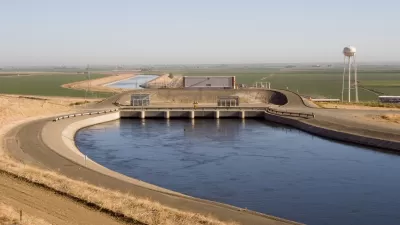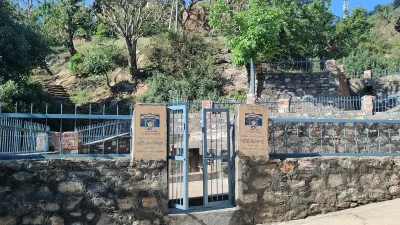Most of us who live in major metropolitan areas know that urban water supplies are dwindling. The question is: what can we do about it?
A just-released Nature Conservancy study [PDF] suggests that the best way to improve water conditions in both urban and rural areas is to form partnerships between their inhabitants. After all, the two spaces are intimately connected, in terms of water use: farming consumes the majority of a region's water supply, while urban residents consume most of the food produced in rural areas.
Farmer-city partnerships seem more promising than current stopgaps, Eric Jaffe writes, including importing water from other regions and recycling or desalination. A sustainable partnership program would involve center-city funding of water conservation techniques on the periphery, including changing the crops planted on agricultural land. Both sides of the equation would save money, on irrigation and fresh food, respectively.
Of course, both farmers and urban governments may be hesitant to start a water-saving partnership. But existing experiments in southern California and elsewhere have proven that overcoming obstacles to cooperation is worth it. In San Diego, for instance, agricultural water conservation already accounts for over one-quarter of the city’s water supply; by 2020, the proportion is expected to reach 36 percent.
FULL STORY: How to Save Water-Starved Cities

Alabama: Trump Terminates Settlements for Black Communities Harmed By Raw Sewage
Trump deemed the landmark civil rights agreement “illegal DEI and environmental justice policy.”

Planetizen Federal Action Tracker
A weekly monitor of how Trump’s orders and actions are impacting planners and planning in America.

The 120 Year Old Tiny Home Villages That Sheltered San Francisco’s Earthquake Refugees
More than a century ago, San Francisco mobilized to house thousands of residents displaced by the 1906 earthquake. Could their strategy offer a model for the present?

Ken Jennings Launches Transit Web Series
The Jeopardy champ wants you to ride public transit.

BLM To Rescind Public Lands Rule
The change will downgrade conservation, once again putting federal land at risk for mining and other extractive uses.

Indy Neighborhood Group Builds Temporary Multi-Use Path
Community members, aided in part by funding from the city, repurposed a vehicle lane to create a protected bike and pedestrian path for the summer season.
Urban Design for Planners 1: Software Tools
This six-course series explores essential urban design concepts using open source software and equips planners with the tools they need to participate fully in the urban design process.
Planning for Universal Design
Learn the tools for implementing Universal Design in planning regulations.
Clanton & Associates, Inc.
Jessamine County Fiscal Court
Institute for Housing and Urban Development Studies (IHS)
City of Grandview
Harvard GSD Executive Education
Toledo-Lucas County Plan Commissions
Salt Lake City
NYU Wagner Graduate School of Public Service




























